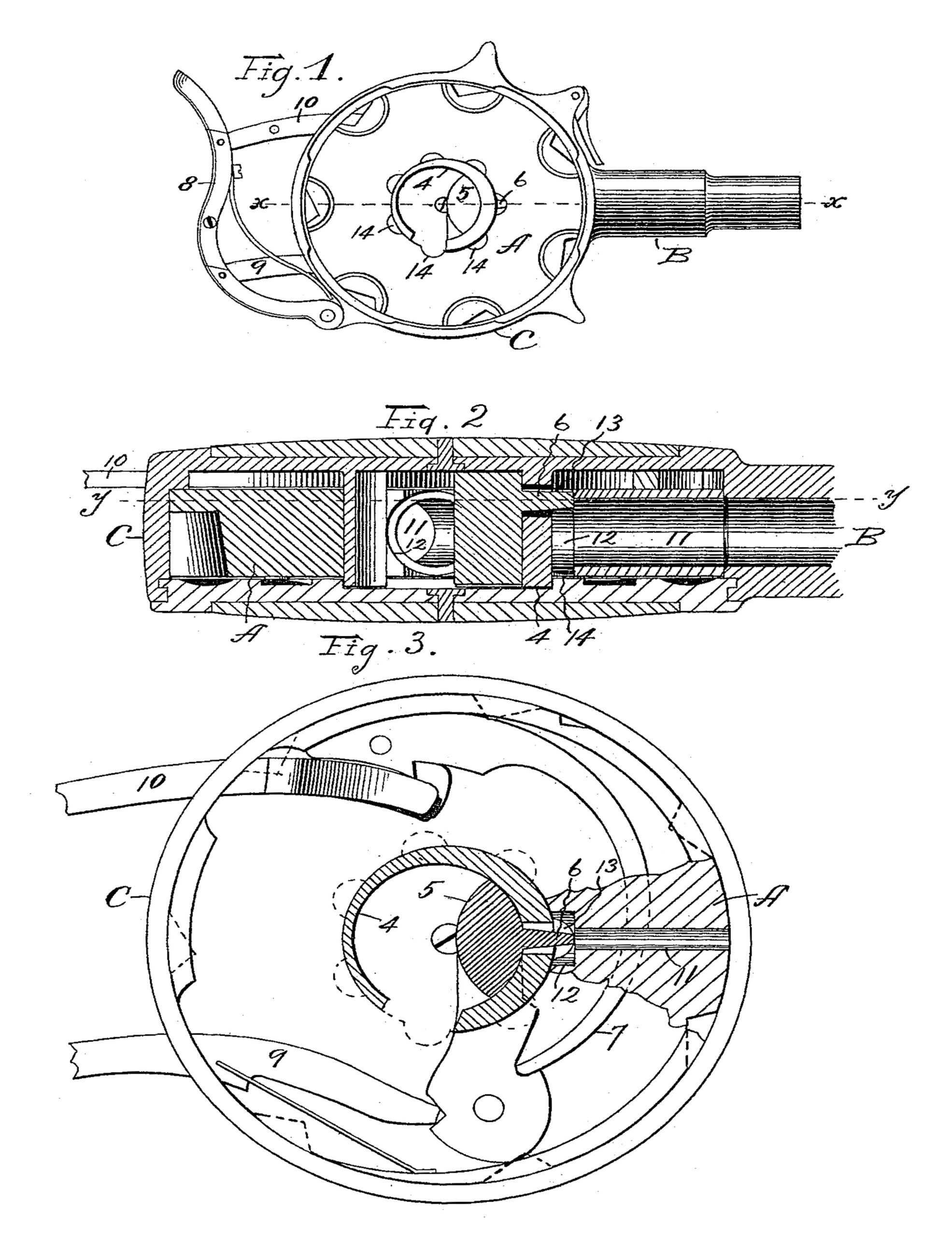US 528263
UNITED STATES PATENT OFFICE.
OLIVER E. SMITH, OF CHICOPEE, MASSACHUSETTS, ASSIGNOR TO JUSTIN P.
WOODWORTH, OF SAME PLACE.
REVOLVER.
SPECIFICATION forming part of Letters Patent No. 528,263, dated October 30, 1894.
Application filed May 4, 1894. Serial No. 510,080. (No model.)
To all whom it may concern:
Be it known that I, OLIVER E. SMITH, a citizen of the United States, residing at Chicopee, in the county of Hampden and State of Massachusetts, have invented certain new and useful Improvements in Revolvers, of which the following is a specification.
My invention relates to improvements in revolvers, and the objects of my improvement are to prevent the revolving carrier block from being bruised or marred, and to indicate when it contains shells.
In the accompanying drawings: Figure 1 is a side elevation of my revolver with the cap plate removed. Fig. 2 is an enlarged sectional view of the same on the line x x of Fig. 1 and Fig. 3 is a sectional view of the same on the line y y of Fig. 2,a portion of the revolving carrier block being broken away in order to better show the other parts.
My improvement relates to that class of revolvers in which the revolving carrier block is in the form of a perforated disk with the shell chambers radiating outwardly and adapted to be filled from the opening in the middle portion of the block.
A designates the revolving carrier block which in the main is in disk form and is mounted upon the hollow stud 4 within which the hammer 5 and firing pin 6 are arranged. The barrel B and case C may be of any ordinary construction and any ordinary means may be employed for intermittently revolving the carrier block and tripping the hammer.
As shown, 7 designates the spring which actuates the hammer. 8 is the operating lever which carries the trip 9 for acting on the heel of the hammer and the pawl arm 10 for engaging suitable ratchet teeth on one side of the carrier block and moving it forward intermittently. These parts are of ordinary construction and for them other known equivalents may be substituted.
The carrier block A is shown as provided with seven barrels or chambers 11, each of which radiates outwardly, and is counterbored at its inner end, as at 12, to receive the rim of the shells. The firing pin 6 is arranged to strike in the rim receiving counterbore near one side of the carrier block so as to hit the rim of the cartridge, as best shown in Fig. 3, whereby said pin works very closely to the side surface of the carrier block.
My improvement consists in recessing or cutting away the side wall of the carrier block adjacent to the firing pin, and rim receiving counterbore, whereby it is impossible for the firing pin to bruise or mar the shell chamber and thereby interfere with the free introduction of the shells. One of these recesses 13 is shown in Fig. 3, while the firing pin is shown as resting by the side of one of said recesses in Fig. 2. I prefer to form like recesses 14 on the opposite side of the carrier as best shown in Fig. 1. In Fig. 3, I have indicated in broken lines the general contour of the carrier block A which has been broken away in order to show the other parts. By thus providing the carrier block with a side recess or recesses at its rim receiving counterbore, I am enabled to make the hammer pin properly strike the rim of the shell without any danger of marring the rim receiving recess, and I am also enabled to see at a glance whether or not there are any shells within the carrier block.
I claim as my invention—
1. The combination of the hammer and firing pin with the revolving carrier block having the chamber 11, rim receiving counterbore 12, and the open side recess 13 immediately adjacent to the hammer pin, substantially as described and for the purpose specified.
2. In a revolver of the class described, the revolving carrier block A having the chambers or shell recesses 11 with the rim receiving counterbore 12, and open side recess opposite said rim receiving recess, substantially as described and for the purpose specified.
OLIVER E. SMITH.
Witnesses:
A. W. STIPEK,
JAMES SHEPARD.

